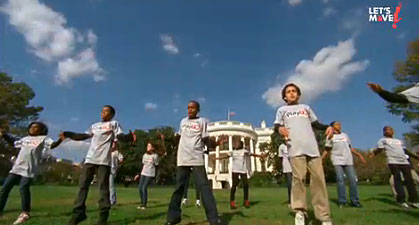 Kids exercise in a video from Lets Move, Michelle Obama’s campaign to fight childhood obesity. The do-or-die moment for school food approaches — the House is due to take up its version of the school lunch re-authorization bill, also known as the “Healthy, Hunger-Free Kids Act,” later this month. Of course, even if it passes, the differences between the House and Senate versions must be reconciled before the bill can become law. And if Congress is unable to act between now and December, school lunch reform will have to start from scratch come January with a new and more Republican Congress.
Kids exercise in a video from Lets Move, Michelle Obama’s campaign to fight childhood obesity. The do-or-die moment for school food approaches — the House is due to take up its version of the school lunch re-authorization bill, also known as the “Healthy, Hunger-Free Kids Act,” later this month. Of course, even if it passes, the differences between the House and Senate versions must be reconciled before the bill can become law. And if Congress is unable to act between now and December, school lunch reform will have to start from scratch come January with a new and more Republican Congress.
With the stakes so high, First Lady Michelle Obama renewed her call for passage at a speech in Louisiana the other day and in doing so, directly linked school lunch reform to her larger Let’s Move anti-obesity initiative. “It’s important to be clear,” she declared. “Unless we pass the Child Nutrition legislation that’s before Congress right now,” Let’s Move may fail.
Yet, while she mentioned the “critically needed investments” the reform bill will offer schools — though most advocates believe the bill remains woefully underfunded — she downplayed the biggest impact that passage of the school lunch reform bill may have. If the bill becomes law, then for the first time the USDA will wrest control from local school districts and their food company partners of so-called “competitive foods” in school. These are the products that schools sell to students to subsidize the costs of feeding low-income kids (since government money doesn’t cover the full cost of school meals). While most schools have restrictions on the nutritional value of the meals themselves, the “competitive foods” don’t — and that’s how food companies and cash-starved school boards sneak soda, chips, cookies, brownies, and other sugary and salty treats into school vending machines, stores and snack bars and thence into schoolkids’ daily diet.
But the reform bill would go a long way toward ending all that. The USDA would be able to set standards for these other foods — although, as good-food advocate Jill Richardson pointed out recently, it’s premature to assume that it will lead to a junk-food ban. But if nothing else, it will begin a needed debate over these foods.
Richardson rightly asks, “If the schools were relying on junk food for money, what will they do when the junk food goes away?” Even so, we can’t have a system that requires kids to eat junk so that schools can afford to serve them a healthy meal.
Indeed, the fight against childhood obesity may hinge on this issue of junk “competitive” foods in schools. A study by a team from the University of Michigan Medical School just published in the Journal of School Health looked specifically at kids’ consumption of foods sold in vending machines, school stores, and snack bars (but outside the cafeteria) and concluded that these foods play a large role in schoolkids’ poor diets.
The researchers found that over 20 percent of schoolkids ate from one of these school-based sources of junk food on a given day — including over 50 percent of middle schoolers and almost 90 percent of high schoolers. Interestingly, kids who received free or subsidized meals ate these foods at about the same rate, so price is not stopping even low-income kids from hitting the vending machines.
These foods were significantly higher in calories and sugar, and lower in fiber and other nutrients than the food served in the cafeteria. As a result, kids who ate them were on average consuming an extra 250 calories a day. Given that even 100 excess calories can lead to obesity, the researchers note that this finding has huge implications for public health.
In short, allowing “competitive” foods in schools makes kids’ diets worse — and clearly contributes to childhood obesity.
All this to say: Congress, pass the damn bill.



